Biomotion & Stretch Tech: Safety Meets Comfort
No matter what time of the day, workers are susceptible to the dangers that arise during construction, roadworks, and related maintenance activities....
Who would have thought over 90 years ago the first high-vis garment was born, unsurprisingly because of an industrial accident that inventor Bob Switzer had suffered. With his eyesight affected and restricted to a darkened room for several months, this triggered his and his brother’s exploration with black-light fluorescent materials and paints, and the founding of the Day-Glo Corporation.
During World War II the company developed daylight fluorescent pigments, with Bob’s first test garment being his wife’s wedding dress. Since then, fluorescent dyes have become an essential part of personal protective equipment (PPE) across many industries.
Until recently in Australia, the staple colours of high-vis clothing have been red, red-orange, orange, yellow and yellow green. To enhance safety and improve delineation on worksites, the Australian/New Zealand Standard AS/NZS 1906.4-2023 for High-Visibility Materials for Safety Garments has now introduced two vibrant new colours to its approved palette: pink and green.
The introduction of pink and green to the high-visibility standard is not just about aesthetic diversity; it’s a practical response to the need for greater contrast in specific work environments. While traditional orange vests are effective against dark surfaces like bitumen, they may not stand out well in other settings.
Pink, with its sharp contrast against green and brown backdrops is useful in forestry and landscaping. The new green is becoming more popular in urban and emergency services setting to make it possible to provide a level of differentiation between various emergency services. Both offer valuable alternatives that enhance workplace safety.
Alan Parker, a veteran of 30 years in the high-visibility safety space and the key proponent of the revised standard, highlighted the importance of these colours. “A high-visibility colour is made to be seen especially when someone is not specifically looking for, or is unaware of another person’s presence. The brightness of the colour needs to stand out both as a bright colour and importantly against the colouring of the environment and background to alert a viewer that there is a person there,” Parker explains. “These new colours ensure that high-visibility vests are not only attention-grabbing but also stand out distinctly against potentially camouflaging backgrounds.”
Having a variety of standards approved high-visibility colours onsite, can also serve to distinguish between responsibilities on a site making key people more easily identifiable.
According to Parker, many groups were increasingly using bright pink for safety vests, not knowing that it was not a legal and legitimate safety colour. Bringing it into the standard ensures it is governed by regulations to offer adequate visibility. These regulations require it to have a defined colour, performance, brightness and durability to be compliant.
Some factors that support a compliant high-visibility safety garment:
The colour – It needs to fall within a certain range of chromaticity co-ordinates to ensure the accuracy of the colour spectrum deemed the brightest of that particular colour.
The luminance (brightness) – It needs to absorb UV light (in the case of synthetic material) and re-emit this as visible light.
Visibility - It needs to stand out against the background in which a person is working.
Durability - It needs to withstand a certain amount of washes and not fade too quickly.
“When daylight is low, there is still a lot of UV light present. Fluorescent colours enable visibility across various lighting and weather conditions, from bright daylight to dusk and dawn and cloudy rainy days,” Parker explains, “because UV light is present at dusk and dawn and it passes through the clouds on wet and overcast days”.
The new standard does not mandate specific colours for particular industries; instead, it allows your business to choose the most appropriate colour based on your unique settings. This approach means you can tailor your safety strategy to your site and purpose, enhancing the effectiveness of high-visibility gear in protecting your workers.
With the addition of pink and green, the high-visibility standard now encompasses a more comprehensive spectrum of colours. One thing to note, however, is that pink and green coloured garments produced before June 2023 may not comply with the new standard. That’s why it’s important to get your high-vis gear from a provider you can trust. At Blackwoods, our range featuring the new pink options will be available by September this year.
Terry Meachen, Major Projects Manager at Blackwoods, remarked, “The addition of pink and green not only enhances safety but also supports the specific needs of various industries, helping them to implement more effective and tailored safety protocols.” When asked why he decided to come out of retirement to tackle the complicated challenge of getting the standard revised, Parker replied, “I recognised the need for these colours to be included and as a member of the joint Australia and New Zealand Standards technical committee I thought it important enough, so I took it on myself.”
We appreciate his hard work to ensure we can make the best attempt to keep our workforce safe.
Related Articles
| How Biomotion and Stretch Tech are Shining Bright for Safety and Comfort |
Safety Apparel Better Suited To Australia’s Climate |
Layering For All Seasons |
Biomotion is no longer a niche term |

No matter what time of the day, workers are susceptible to the dangers that arise during construction, roadworks, and related maintenance activities....